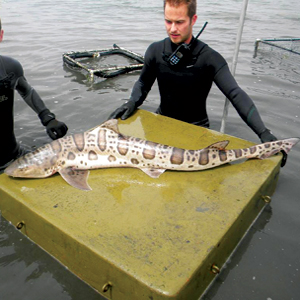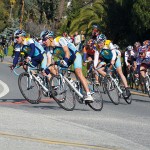In Palo Alto last Friday morning, a man walking along the bay shore found a dead leopard shark. Not far away he found a live one, thrashing in the shallows. He delivered the animal to the Peninsula Humane Society and SPCA in San Mateo, and eventually it was FedExed to the Department of Fish and Game’s lab near San Diego.
It was just one of scores of leopard sharks that have been found thrashing and dying in the shallows of San Francisco Bay from Palo Alto to Marin, as the cause of an apparent epidemic eludes baffled scientists.
An unknown number of the 3- to 5-foot-long animals have been affected, though the victims likely number well into the hundreds. Several specimens have been sent to a Department of Fish and Game toxicology lab, where necropsies have found inflammation and lesions in the animals’ brains, and in some specimens hemorrhaging around internal organs. Microscopic tissue analyses are now underway, with results pending.
Department of Fish and Game officials confirmed that they are studying the phenomenon, but have no idea what is going on.
“We are actively researching the situation along with other university scientists,” says Fish and Game’s Carrie Wilson. “We are continuing to collect sharks and trying to determine if we can draw any conclusions. At this point we still don’t know why they have died.”
The first dead sharks appeared in April in a storm-water retention lagoon in Redwood Shores. Malcolm Smith, a city spokesman in Redwood City, says the first documented case occurred on April 21—but it appears that ailing leopard sharks began turning up in the first week of April.
In the days and weeks following, dozens of dead and dying sharks were seen around the lagoon. Those still alive exhibited similar behavior—persistently pushing their way onto shore, often in spite of bystanders’ efforts to nudge them back toward deeper water.
Then the event spread.
“We’ve seen it go right up the peninsula, to Marin County,” says Brandy Faulkner, a researcher with the Santa Cruz-based Pelagic Shark Research Foundation, which has led the response effort. “It’s proliferating from one hot spot, in Redwood Shores, but it has spread all over the bay.”
Faulkner believes an “infection” may have originated in a Redwood Shores lagoon and killed the sharks present in its waters, before spreading into the bay.
{pagebreak}
A second hot spot of stranded shark sightings has been Richardson Bay, just seaward of the Tiburon Peninsula in Marin County. More recently, the animals have been been reported beaching themselves at Fort Baker, just inside the Golden Gate in Marin County, and on several coastal beaches to the south.
Sean Van Sommeran, executive director of the Pelagic Shark Research Foundation, has also speculated that waters in Redwood Shores lagoon, which is relatively isolated from the tidal motions of the greater bay, may have stagnated and spawned a pathogen that killed the fish—though he too is puzzled. Redwood City’s Public Works wastewater superintendent Marilyn Harang suspects that something “systemic” to the entire bay, or to leopard sharks, is killing the fish. Smith elaborated on the same point in a written statement released to the press on May 11, suggesting that “something specific to this particular species, rather than some kind of a pollutant or contamination” might be to blame.
Lower salinity levels, caused by heavy runoff from winter storms, have been considered a possibility. Between mid-January and mid-April, testing of water samples found that the South Bay’s water was heavily diluted by rainwater.
The average salinity of open ocean water is 35 parts per thousand. On April 8, for instance, a United States Geological Survey sample showed a salinity level of eight parts per thousand. On April 12, Department of Fish and Game samples were measured at 13 to 18 parts per thousand. And six samples collected on April 27 from the Redwood Shores lagoon were found to contain just 13 to 17 parts per thousand of salinity.
These low salinity levels could certainly kill leopard sharks, according to Dr. Wes Dowd, a postdoctoral fellow at Stanford University’s Hopkins Marine Laboratory who has studied leopard sharks and their resilience to varying salinity levels.
“In Elkhorn Slough [in Watsonville], leopard sharks seem to run when salinity drops to 19 parts per thousand,” Dowd said. He says, sharks and rays are less tolerant of changing salinity than are bony fishes, like surfperch and striped bass, which might explain why leopard sharks have made up the vast majority, if not the entirety, of the victims.
But in the past weeks, at least four dying leopard sharks have been seen in ocean waters, which are less subject to high salinity fluctuations than those of enclosed, shallow bays.
National Park Service lifeguard Sean Scallan, who saw three of the animals, says leopard sharks have beached themselves in past years—but no prior events have matched the scale or persistence of the current one, he says.
Widespread fish kills have occurred before in San Francisco Bay. In the summer of 2006, hundreds of dead sharks, bat rays and striped bass appeared along the shoreline of the South Bay. Van Sommeran and Faulkner, both of whom saw the dead fish littering the beaches, point out that the die-off was preceded by a toxic spill of bittern, an extremely saline byproduct of salt production, at the Dumbarton Bridge. Though no cause-effect relation was officially recognized between the spill and the fish die-off, Cargill Salt, which had caused similar spills previously, eventually paid a fine of $228,000.
Van Sommeran and Faulkner ask anyone who encounters a dying shark to note the location, photograph the animal and contact the Foundation at 831-459-9346.

 Food & Wine Events: May 18-25
Food & Wine Events: May 18-25  Amgen Tour Hits San Jose
Amgen Tour Hits San Jose 


